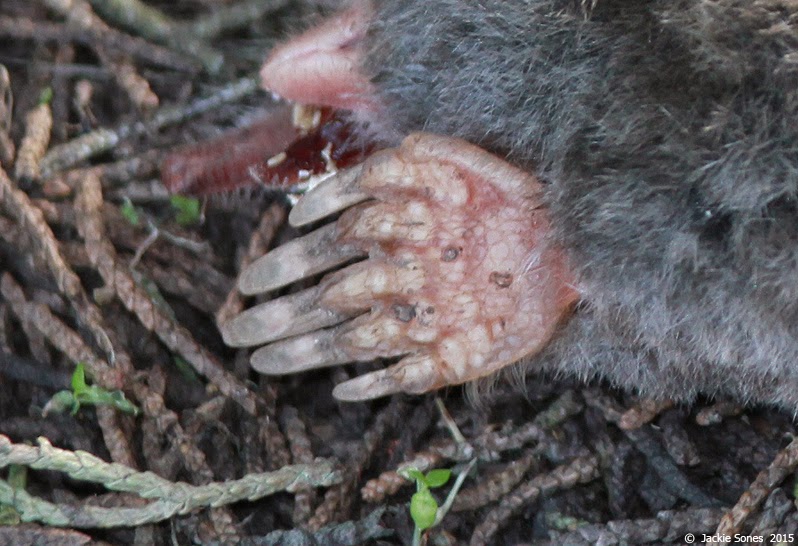Have you seen this species before? I'm guessing you've at least noticed evidence of its subterranean runways on the surface of the ground.
There are four species of moles that live in California, two of which have been recorded on Bodega Head. I showed one species, the American Shrew-Mole, on 9 February 2013 (review that post here). The mole pictured above is a Broad-footed Mole (Scapanus latimanus).
I used the name "Broad-footed Mole" because that's the name commonly used by other sources. But I was tempted to rebel and use "Broad-handed Mole" because the species name, "latimanus" translates directly into "broad hand." And a broad hand it is!
The entire mole was ~14 cm long. The front "hand" was ~2 cm long and ~1.5 cm wide. Note that the claws are quite long and take up ~50% of the hand!
On the opposite end, the hind feet are much, much smaller — not so important for digging.
I'll point out one more important characteristic for now — the tail. If you review the first photo (I'll show it again below), note the length of the tail (is it short or long?) and whether it's covered with hairs or not.
The short, hairy tail helps identify this as a Broad-footed Mole.
P.S. I know this might seem a little random, but whenever I see a mole I almost always think of two things from my past that triggered visualizations of what life might be like for a mole:
- A drawing by one of my favorite illustrators — "Dead End Mole" by Peter Parnall. You can see it here. (Click on the thumbnail to see the complete version.)
- A wonderful book that Julie recommended to me — Duncton Wood by William Horwood. It's written in the style of Watership Down, but with moles instead of rabbits.




5 comments:
Long ago I heard that moles taste bad, which may be why domestic cats and other predators leave them behind.
A quick Google search confirmed the taste.
While we are reviewing the mole literature, let's not leave out the first, and best mole character, in "The Wind in the Willows" by Kenneth Grahame, a classic.
"He saw clearly how plain and simple —- how narrow, even -— it all was; but clearly, too, how much it all meant to him, and the special value of some such anchorage in one's existence. He did not at all want to abandon the new life and its splendid spaces, to turn his back on sun and air and all they offered him and creep home and stay there; the upper world was all too strong, it called to him still, even down there, and he knew he must return to the larger stage. But it was good to think he had this to come back to; this place which was all his own, these things which were so glad to see him again and could always be counted upon for the same simple welcome." -- thought Mole in The Wind in the Willows
My first encounter with a mole sent me and my friend running for our lives, as we imagined a "green hand", probably Martian, trying to emerge from beneath the leaves in a dark forest. An older kid stopped us and made us lead him back out there to show him, and he actually caught the mole and let us pet the thing.
In the 1970s I observed a great blue heron stalking prey in a small pasture near Bolinas, along the lagoon. It stabbed it's bill diagonally into the ground and came up with a mole! (Identified at a distance by observing the broad hands.)
Post a Comment